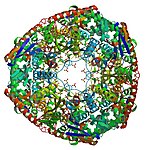SOX6
 Questa voce è orfana, ovvero priva di collegamenti in entrata da altre voci.
Questa voce è orfana, ovvero priva di collegamenti in entrata da altre voci.Inseriscine almeno uno pertinente e utile e rimuovi l'avviso. Segui i suggerimenti del progetto di riferimento.
Il fattore trascrizionale SOX-6 è una proteina codificata negli esseri umani dal gene SOX6.[1][2]
| SOX-6 | |
|---|---|
 | |
| Gene | |
| HUGO | SOX6 HSSOX6 |
| Entrez | 55553 |
| Locus | Chr. 11 [1] |
| Proteina | |
| OMIM | 607257 |
| UniProt | P04637 |
| Modifica dati su Wikidata · Manuale | |
La famiglia dei geni SOX codifica per un gruppo di fattori trascrizionali caratterizzati dal dominio HMG (high mobility group), un dominio di legame al DNA. I fattori trascrizionali SOX, a differenza della maggior parte dei fattori trascrizionali, si legano al solco minore del DNA piegando la doppia catena di un angolo di 70-85 gradi e introducendo cambiamenti conformazionali locali.[2]
Interazioni
È stato dimostrato che SOX6 interagisce con CTBP2[3] e CENPK.[4]
Note
- ^ Cohen-Barak O, Hagiwara N, Arlt MF, Horton JP, Brilliant MH, Cloning, characterization and chromosome mapping of the human SOX6 gene, in Gene, vol. 265, n. 1-2, marzo 2001, pp. 157-64, PMID 11255018.
- ^ a b Entrez Gene: SOX6 SRY (sex determining region Y)-box 6, su ncbi.nlm.nih.gov.
- ^ A Murakami, Ishida S, Thurlow J, Revest J M, Dickson C, SOX6 binds CtBP2 to repress transcription from the Fgf-3 promoter, in Nucleic Acids Res., vol. 29, n. 16, England, agosto 2001, pp. 3347-55, PMID 11504872.
- ^ A Yamashita, Ito M, Takamatsu N, Shiba T, Characterization of Solt, a novel SoxLZ/Sox6 binding protein expressed in adult mouse testis, in FEBS Lett., vol. 481, n. 2, NETHERLANDS, settembre 2000, pp. 147-51, ISSN 0014-5793 (WC · ACNP), PMID 10996314.
Bibliografia
- Denny P, Swift S, Brand N, et al., A conserved family of genes related to the testis determining gene, SRY., in Nucleic Acids Res., vol. 20, n. 11, 1992, p. 2887, DOI:10.1093/nar/20.11.2887, PMID 1614875.
- Lefebvre V, Li P, de Crombrugghe B, A new long form of Sox5 (L-Sox5), Sox6 and Sox9 are coexpressed in chondrogenesis and cooperatively activate the type II collagen gene., in Embo J., vol. 17, n. 19, 1998, pp. 5718–33, DOI:10.1093/emboj/17.19.5718, PMID 9755172.
- Hagiwara N, Klewer SE, Samson RA, et al., Sox6 is a candidate gene for p100H myopathy, heart block, and sudden neonatal death., in Proc. Natl. Acad. Sci. U.S.A., vol. 97, n. 8, 2000, pp. 4180–5, DOI:10.1073/pnas.97.8.4180, PMID 10760285.
- Yamashita A, Ito M, Takamatsu N, Shiba T, Characterization of Solt, a novel SoxLZ/Sox6 binding protein expressed in adult mouse testis., in FEBS Lett., vol. 481, n. 2, 2000, pp. 147–51, DOI:10.1016/S0014-5793(00)01987-6, PMID 10996314.
- Hartley JL, Temple GF, Brasch MA, DNA cloning using in vitro site-specific recombination., in Genome Res., vol. 10, n. 11, 2001, pp. 1788–95, DOI:10.1101/gr.143000, PMID 11076863.
- Wiemann S, Weil B, Wellenreuther R, et al., Toward a catalog of human genes and proteins: sequencing and analysis of 500 novel complete protein coding human cDNAs., in Genome Res., vol. 11, n. 3, 2001, pp. 422–35, DOI:10.1101/gr.154701, PMID 11230166.
- Murakami A, Ishida S, Thurlow J, et al., SOX6 binds CtBP2 to repress transcription from the Fgf-3 promoter., in Nucleic Acids Res., vol. 29, n. 16, 2001, pp. 3347–55, DOI:10.1093/nar/29.16.3347, PMID 11504872.
- Strausberg RL, Feingold EA, Grouse LH, et al., Generation and initial analysis of more than 15,000 full-length human and mouse cDNA sequences., in Proc. Natl. Acad. Sci. U.S.A., vol. 99, n. 26, 2003, pp. 16899–903, DOI:10.1073/pnas.242603899, PMID 12477932.
- Cohen-Barak O, Yi Z, Hagiwara N, et al., Sox6 regulation of cardiac myocyte development., in Nucleic Acids Res., vol. 31, n. 20, 2004, pp. 5941–8, DOI:10.1093/nar/gkg807, PMID 14530442.
- Ota T, Suzuki Y, Nishikawa T, et al., Complete sequencing and characterization of 21,243 full-length human cDNAs., in Nat. Genet., vol. 36, n. 1, 2004, pp. 40–5, DOI:10.1038/ng1285, PMID 14702039.
- Wiemann S, Arlt D, Huber W, et al., From ORFeome to biology: a functional genomics pipeline., in Genome Res., vol. 14, 10B, 2004, pp. 2136–44, DOI:10.1101/gr.2576704, PMID 15489336.
- Ueda R, Yoshida K, Kawakami Y, et al., Expression of a transcriptional factor, SOX6, in human gliomas., in Brain tumor pathology, vol. 21, n. 1, 2005, pp. 35–8, DOI:10.1007/BF02482175, PMID 15696967.
- Ueda R, Yoshida K, Kawakami Y, et al., Immunohistochemical analysis of SOX6 expression in human brain tumors., in Brain tumor pathology, vol. 21, n. 3, 2005, pp. 117–20, DOI:10.1007/BF02482186, PMID 15696972.
- Mehrle A, Rosenfelder H, Schupp I, et al., The LIFEdb database in 2006., in Nucleic Acids Res., vol. 34, Database issue, 2006, pp. D415–8, DOI:10.1093/nar/gkj139, PMID 16381901.
- Fernández-Lloris R, Osses N, Jaffray E, et al., Repression of SOX6 transcriptional activity by SUMO modification., in FEBS Lett., vol. 580, n. 5, 2006, pp. 1215–21, DOI:10.1016/j.febslet.2006.01.031, PMID 16442531.
- Ikeda T, Saito T, Ushita M, et al., Identification and characterization of the human SOX6 promoter., in Biochem. Biophys. Res. Commun., vol. 357, n. 2, 2007, pp. 383–90, DOI:10.1016/j.bbrc.2007.03.133, PMID 17433257.
V · D · M | ||||||||
|---|---|---|---|---|---|---|---|---|
| Dogma centrale della biologia molecolare | ||||||||
| Espressione genica |
|  | ||||||
| Sintesi proteica | mRNA · tRNA · Ribosoma · Splicing · Modificazione post traduzionale | |||||||
| Tecniche | BioBrick · Clonaggio · PCR · Elettroforesi su gel di agarosio · Elettroforesi su gel di poliacrilammide · Southern blot · Northern blot · Western blot · Sequenziamento · Sequenziamento del DNA | |||||||
 Portale Biologia: accedi alle voci di Wikipedia che trattano di Biologia
Portale Biologia: accedi alle voci di Wikipedia che trattano di Biologia








